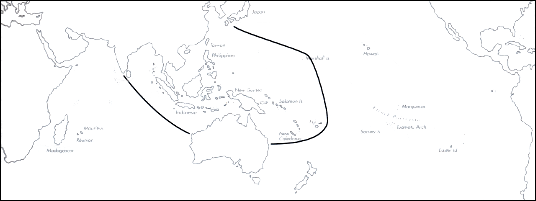
Skip Navigation Links
View access keys for this site.

Range: India to Marshall Is. and Fiji.
Description: Medium-sized to large, moderately solid to heavy. Shells from New Caledonia consistently smaller than shells from other areas; form suffusus (Pl. 1, Fig. 6) also lighter than other forms. Last whorl conical, broadest in form crosseanus (Pl. 1, Figs. 7, 8); outline almost straight, somewhat convex adapically. Shoulder angulate, strongly tuberculate to almost smooth. Spire of low to moderate height, outline straight to slightly concave. Postnuclear spire whorls strongly to weakly tuberculate. Teleoconch sutural ramps concave in late whorls, with 2-4 weak spiral grooves and additional spiral striae; spiral sculpture often obsolete. Last whorl with usually weak, regularly spaced spiral ribs on basal fourth to half.
| Shell Morphometry | ||
|---|---|---|
| L | 50-150 mm | |
| (New Caledonia 40 - 65 mm) | ||
| RW | 0.45-1.95 g/mm (L 50-113 mm) | |
| (form suffusus 0.21 - 0.60 g/mm) | ||
| RD | 0.56-0.65 | |
| (form crosseanus 0.60 - 0.67) | ||
| PMD | 0.85-0.94 | |
| RSH | 0.05-0.15 | |
Ground colour usually white; may be bluish white, pale pink or pale yellow in shells from New Caledonia. Last whorl generally with a regular network of dark brown to black lines and triangular to rhomboid areas, outlining white tents that are often quite uniform in shape and arrangement and usually separate from each other. In New Caledonia, colour of network may grade to orangish red or orangish brown, axial lines may replace network, and pattern may be reduced or absent. Apex purplish red. Postnuclear sutural ramps with a dark brown to black network of lines, streaks and blotches. Aperture white to pinkish orange behind a white marginal zone.
Periostracum yellowish to orangish brown, thin, translucent, smooth.
Dorsum of foot white to tan, mottled with brown, with a black marginal line or band ending in a latero-anterior blotch; a small black triangular blotch at centre either separate from or fusing with lateral blotches. Lateral margins of foot may be flecked with brown; anterior edge of foot occasionally yellow- orange. Sole of foot white to cream, tinged with various shades of brown, with darker brown longitudinal lines. Ventral side of rostrum cream, with tan transverse lines. Tentacles white to light brown; tip white, brown or black; proximal dorsal side often black. Siphon white, sometimes edged with yellow to pale brown; with a black anterior band and a black to brown posterior half-ring or band (Pl. 74, Fig. 1; Pl. 77, First row, left). In subadult specimens from Marshall Is., entire foot with sparse brown mottling on white ground (Walls, [1979]; Chaberman, pers. comm., 1981; Estival, unpubl. observ.; Pearson, unpubl. observ.).
Radular teeth with one barb and a long serration that ends in a cusp at or behind centre of shaft (Bergh, 1895; Peile, 1939; Endean & Rudkin, 1965; Thompson & Bebbington, 1973).Nybakken (1990) reported 2 opposed adapical barb, the anterior of which is laterally inflated; waist and basal spur are absent. In form crosseanus, teeth with an adapical barb opposite a blade, otherwise matching those of typical C. marmoreus (Rolán, 1993).
Habitat and Habits: In 1-15 m. On coral reef platforms and lagoon pinnacles, on coral debris and in sand often under rocks or among weed. In New Caledonia, typical form ranging from 1-5 m, active during the whole day; form crosseanus, form suffusus and intermediates in 1-3 m, active at rising tide; light coloured shells predominantly encountered on fine white sand (Tirard, pers. comm., 1989). C. marmoreus feeds on various gastropods including Conidae. Toxin lethal to mollusks, hardly affecting small mammals (Kohn, Saunders & Wiener, 1960; Endean & Rudkin, 1963; Cruz, Corpus & Oliveira, 1976; Kohn, 1980a; Reichelt & Kohn, 1985; Collins, 1987; Loch, pers. comm., 1987). Egg diameter of 390-400 µm suggests a minimum pelagic period of 7-8 days (data from Philippines, Palau and Marshall Is.; Perron & Kohn, 1985).
Discussion: C. marmoreus is closely related to C. bandanus. For comparison, see the Discussion of that species. The New Caledonian populations of C. marmoreus (Pl. 1, Figs. 5-9) are often considered to represent a separate subspecies (C. m. crosseanus) or species (C. crosseanus). However, except for their smaller size, New Caledonian shells intergrade with C. marmoreus from other localities in all morphological characters and we consider them as form crosseanus, characterized by weakly tuberculate postnuclear whorls and a rather axially lineate dark brown pattern on an often bluish white ground. Specimens with additional spiral ground-colour lines were named var. lineata. Form suffusus (Pl. 1, Fig. 6) has distinct spire tubercles, lacks any pattern elements on its white, pale pink or pale yellow background, and its aperture is pink to orange. Immaculate white shells with a white aperture were described as C. suffusus var. noumeensis. Form pseudomarmoreus (Pl. 1, Figs. 4) is characterized by an almost smooth shoulder. Shells with a typically arranged reddish to brownish orange pattern are known from the Isle of Pines (New Caledonia).

C. marmoreus Range Map
This section contains verbatim reproductions of the accounts of 316 species of Conus from the Indo-Pacific region, from Manual of the Living Conidae, by Röckel, Korn and Kohn (1995). They are reproduced with the kind permission of the present publisher, Conchbooks.
All plates and figures referred to in the text are also in Röckel, Korn & Kohn, 1995. Manual of the Living Conidae Vol. 1: Indo-Pacific Region.
The range maps have been modified so that each species account has it own map, rather than one map that showed the ranges of several species in the original work. This was necessary because each species account is on a separate page on the website and not confined to the order of accounts in the book.
Return to framed version (returns to search page)